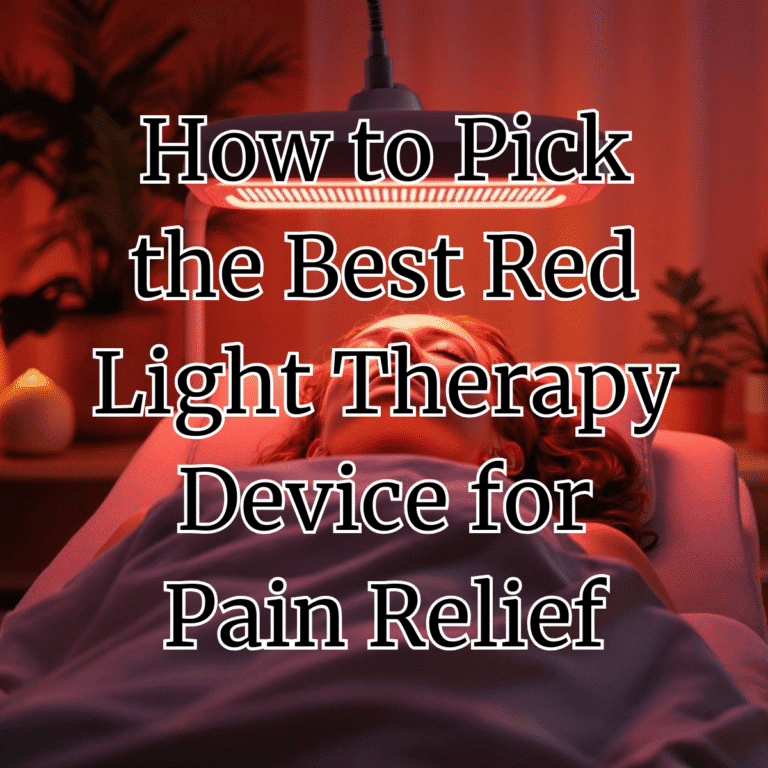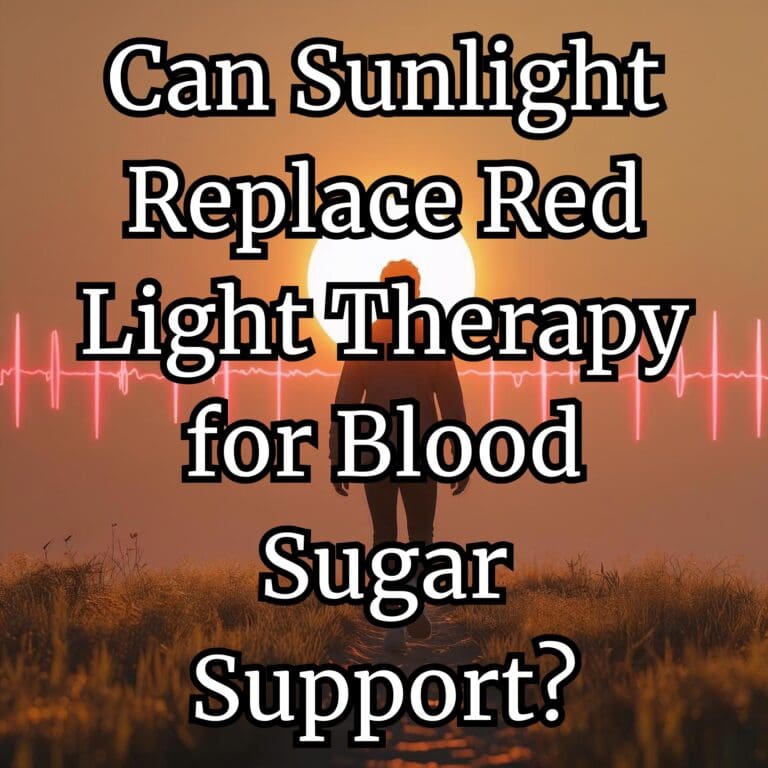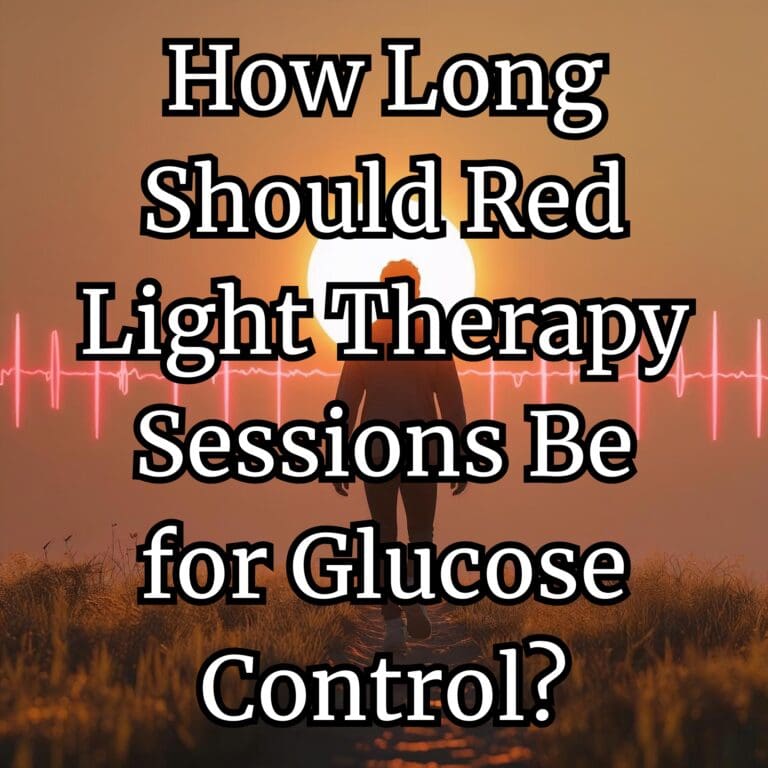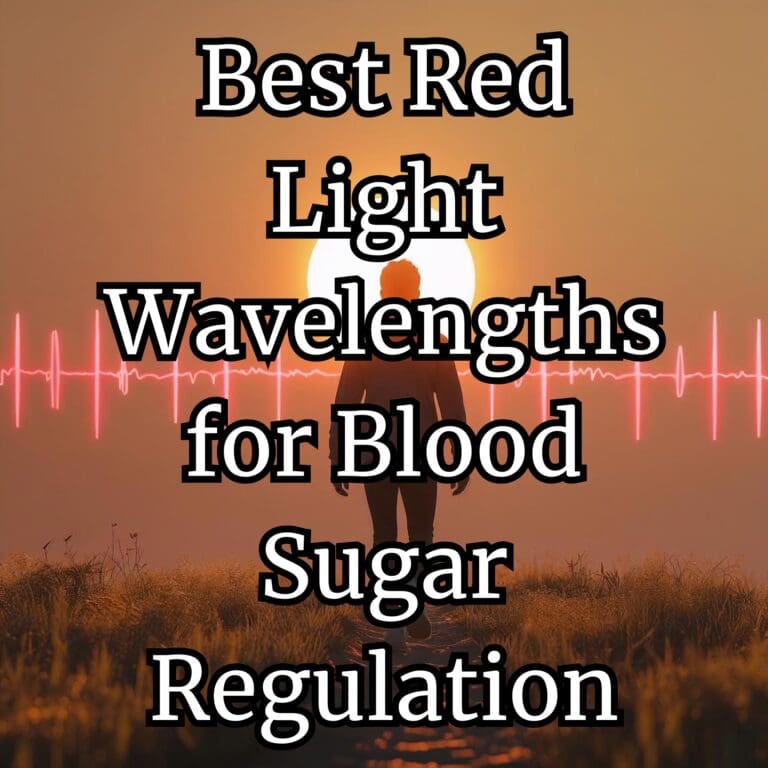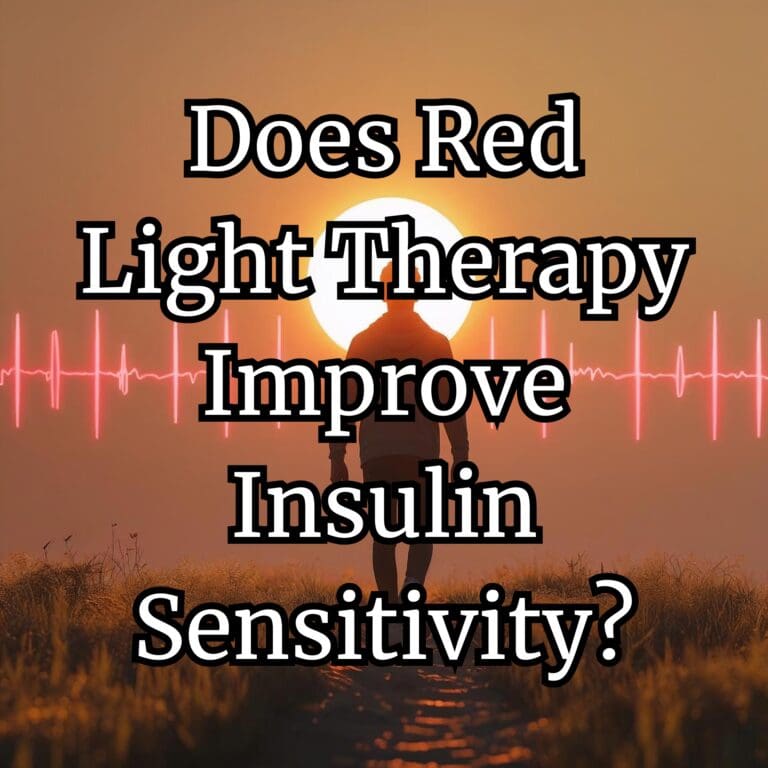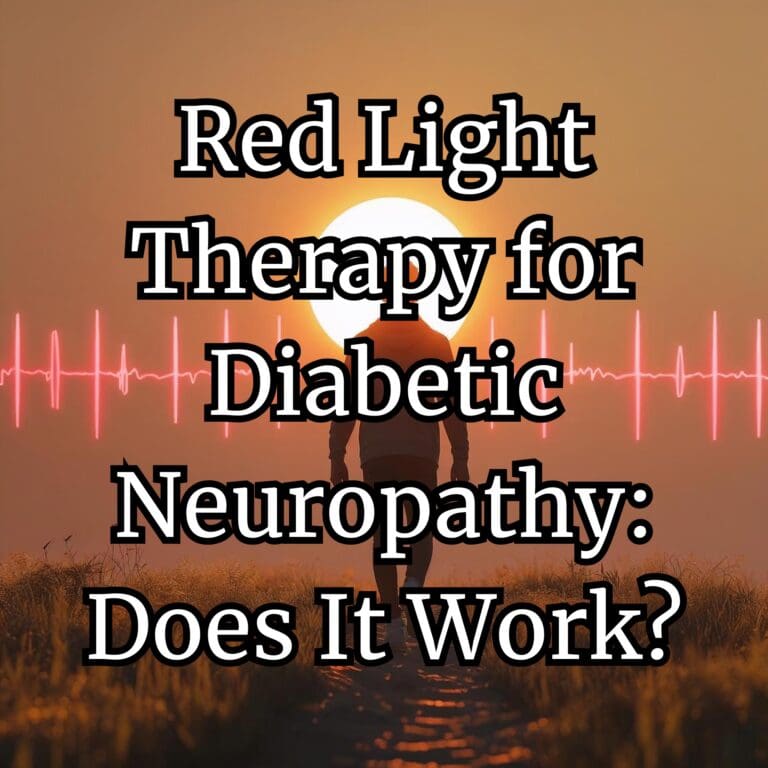- What Is Blue Light Therapy?
- How It Works
- Evidence-Based Benefits
- Acne Treatment
- Safety, Risks & Side Effects
- Devices & At-Home Use
- Search Amazon For Blue Light Therapy Devices
- Blue Light vs. Red Light Therapy
- Who Might Benefit Most
- Blue Light Therapy Podcast
- Blue Light Therapy FAQ
- Summary and Takeaways
- References
- Related Posts
What Is Blue Light Therapy?
Blue light therapy is a treatment that uses specific blue wavelengths of visible light (roughly 415–495 nm) to improve skin and health conditions. In plain English, it means shining blue-colored light (usually from LEDs) on your skin for a therapeutic effect. This is not ultraviolet (UV) light, so it doesn’t cause a tan or sunburn – it’s the same type of blue light found in daylight, but concentrated. Blue light therapy is commonly used in dermatology, especially for treating acne. You might have seen futuristic LED face masks or acne wands – many of those emit blue light. Compared to other colors used in light therapy, blue light sits at the short end of the spectrum. For example, red light (around 600–700 nm) and near-infrared (800+ nm) have longer wavelengths that penetrate deeper, whereas blue light is higher energy but only reaches the surface of the skin. Some devices even combine blue with other colors (like red or green) to tackle different issues at once.
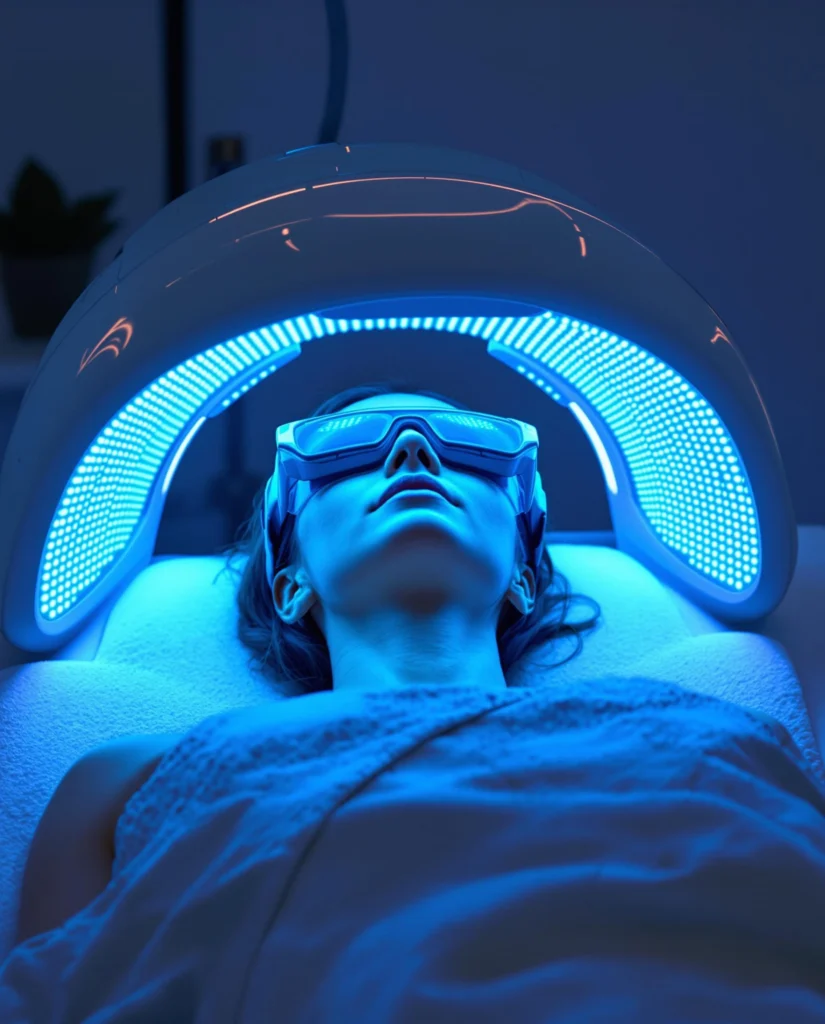
In summary, blue light therapy refers to exposing the skin to blue wavelengths (typically via LEDs) to achieve benefits such as clearer skin or improved mood, without the heat or invasiveness of lasers.
How It Works
Blue light works through photochemical effects in the upper layers of the skin. It only penetrates a few tenths of a millimeter into skin (just the epidermis), which is perfect for targeting things on the surface like bacteria. The key to blue light therapy’s power is that many microbes and cells contain light-sensitive molecules. For instance, the acne-causing bacteria Cutibacterium acnes (formerly Propionibacterium acnes) produces natural compounds called porphyrins. Blue light (around 415 nm) excites these porphyrins and causes a burst of reactive oxygen species (ROS) – basically, free radicals – that kill the bacteria. In simpler terms, blue light makes acne germs self-destruct by lighting up a chemical inside them.
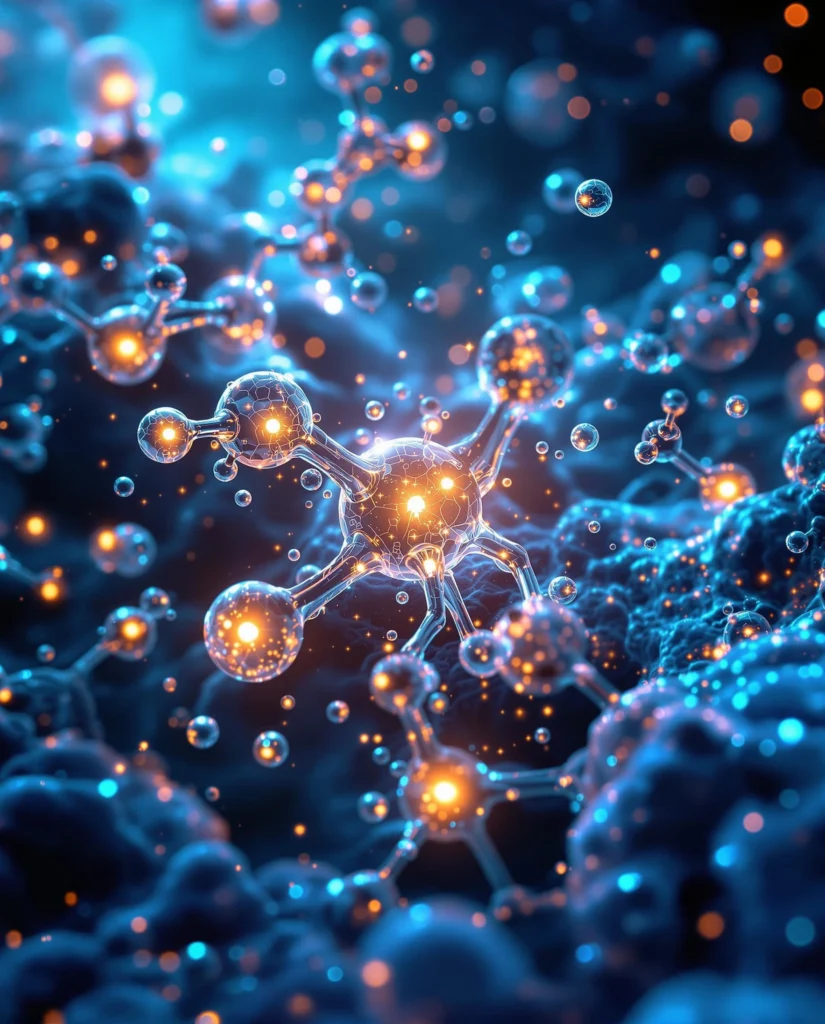
Beyond germ-killing, blue light also seems to have an anti-inflammatory effect on skin cells. Research shows it can dial down the release of inflammatory cytokines (the substances that make pimples red and swollen). This is why blue light might calm redness in acne-prone skin after the bacteria are gone. Blue light’s effects aren’t only skin-deep, though – there’s emerging evidence it can influence our biology in other ways. Blue wavelengths have a strong impact on our circadian rhythm (internal clock) via special receptors in the eyes. During daytime, blue light exposure boosts alertness and even mood. At the skin level, some studies are investigating blue light’s role in modulating inflammation or even pain. However, these systemic effects (like improving mood or reducing inflammation in deeper tissues) are still being researched and are less established than the surface effects. In summary, blue light therapy primarily works by zapping surface bacteria (like those causing acne) through photochemical reactions, and secondarily by reducing inflammation locally – with some intriguing but still preliminary effects on things like circadian rhythm and mood regulation.
Evidence-Based Benefits
Blue light therapy has a variety of claimed benefits, but let’s focus on what science currently supports. Below, we break down the evidence for several key uses:
Acne Treatment
Acne is the headline use for blue light therapy. If you struggle with pimples, especially inflammatory acne, blue light might help. Here’s how: the bacteria C. acnes in your pores emit those porphyrins we mentioned, making them vulnerable to blue light. Shining blue light on acne-prone skin generates bacterial-killing radicals and can clear out P. acnes bacteria and reduce breakouts. Studies have found significant improvements in acne with consistent blue light sessions.

For example, one clinical study found that about 77% of patients saw their acne improve after 5 weeks of blue light therapy. Users often notice fewer active pimples and less redness, since blue light also has a calming, anti-inflammatory effect on sebaceous (oil) glands and skin. That said, it’s not a magic cure or overnight fix. Dermatologists emphasize that light therapy usually needs to be part of a broader acne plan. It typically works best for mild to moderate acne. It may take multiple sessions (often 2+ treatments per week over a month or more) to see results, and even then it rarely clears acne 100% on its own. You might still need a good cleanser, or topical treatments like salicylic acid or retinoids for a full regimen. The good news is that blue light therapy is painless and generally safe, so it’s a useful option for people who can’t tolerate oral medications or want a drug-free maintenance therapy. In practice, dermatologists offer in-office blue light treatments (often a 15-20 minute session under an LED lamp), and there are also at-home devices (more on those later). Overall, the evidence supports blue light therapy as an effective tool to reduce acne bacteria and inflammation, leading to clearer skin for many users – just keep realistic expectations that it’s an add-on treatment, not a standalone “cure”.
Wound Healing
Using blue light to speed up wound healing is a newer, more experimental area. Red and infrared light therapies are more famous for wound healing (due to deeper penetration), but blue light has shown some promise for surface wound care. Scientists have observed that blue light can trigger the release of nitric oxide (NO) and other signaling molecules in tissues, which can increase blood flow and new tissue growth (angiogenesis) at a wound site. Blue light’s antimicrobial action also means it could help disinfect wounds by killing bacteria like Staph or Pseudomonas that sometimes prevent healing.Early preclinical studies in animals and small human case series have reported faster closure of chronic ulcers when low-dose blue light was added to standard care. For example, one review noted a trial where chronic wounds showed a ~51% greater reduction in area with blue light treatment versus standard care alone.
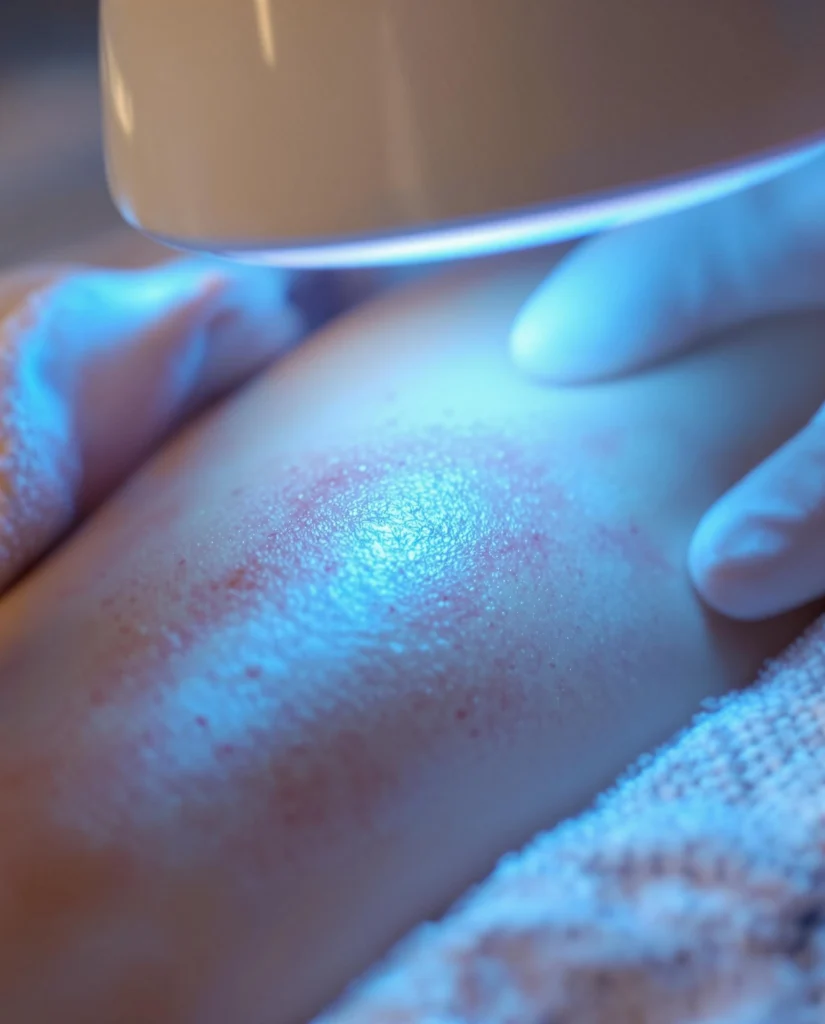
However, it’s important to note that evidence here is still limited and low-quality. Experts consider blue light for wound healing “promising but not proven” – only a few small studies have been done, and some results are mixed. Intriguingly, the beneficial effects seem to depend on using low doses of blue light; higher doses might actually slow healing or damage tissue. So if blue light is used, it has to be carefully controlled. As of now, you won’t find blue light as a routine wound treatment in most clinics, but research is ongoing. If you have a stubborn wound, do not just shine any blue gadget on it without medical guidance. In summary, blue light may help certain wounds by killing bacteria and reducing inflammation, but more clinical trials are needed before we know if it really speeds healing in practice.
Mood and Circadian Rhythm Support
Light therapy is a well-established treatment for Seasonal Affective Disorder (SAD) and circadian rhythm problems – and blue light plays a starring role here. Bright white light boxes used for winter depression actually owe much of their effectiveness to the blue wavelengths they contain. Blue light is the most potent part of the spectrum for regulating our internal body clock. Special receptors in our eyes (melanopsin cells) are tuned to blue light and send signals to the brain’s circadian center. Exposure to blue light (especially in the morning) can boost alertness, improve energy, and align your sleep-wake cycle. In fact, research has shown that short-wavelength blue light has the strongest effect on circadian rhythms – stronger than green or red light.
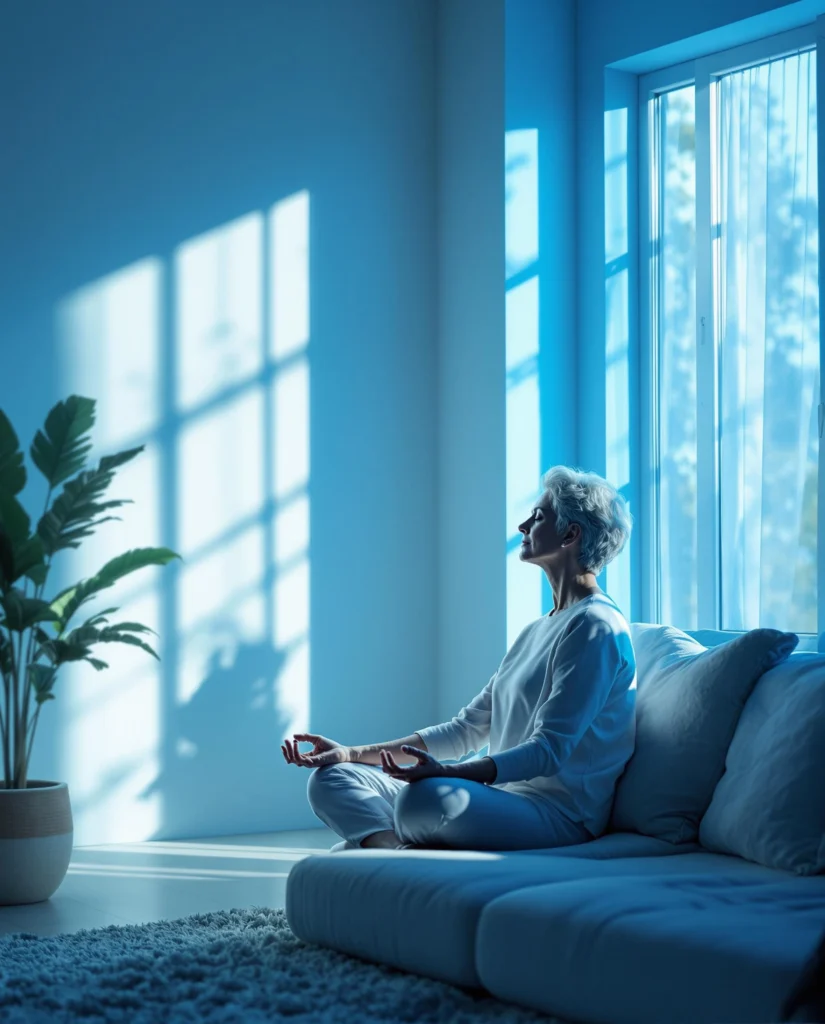
This has been tested in mood disorder therapy: one study found that a low-intensity narrow-band blue light treatment (around 468 nm) was just as effective as the standard high-intensity white light for treating seasonal depression. This means people might get mood benefits with a gentler, blue-enriched light rather than sitting in extremely bright light. Some biohackers also use blue light in the morning for a cognitive boost or to combat the “winter blues.” However, timing is everything – blue light at night is actually disruptive (it suppresses melatonin twice as much as green light) and can worsen sleep if used late. So any blue light therapy for mood should be done early in the day. It’s also worth noting that for full-blown depression or serious circadian disorders, light therapy (blue or otherwise) should be guided by a professional. The evidence so far suggests blue light can support alertness and seasonal mood when used appropriately, though it’s not a replacement for other treatments. Think of it as leveraging the “wake up” signals of natural morning light to help you feel more energized and upbeat.
Anti-Bacterial and Skin Clarity (Beyond Acne)
Blue light’s germ-killing ability isn’t limited to acne bacteria – this therapy has broader antimicrobial potential. Scientists have found that blue light in the 405–470 nm range can inactivate a variety of pathogens without needing any chemicals or drugs. Unlike UV light (which is also germicidal but can harm us), blue light is much gentler to human cells while still stressful to microbes. At sufficient doses, blue light has been shown to have a broad-spectrum antibacterial effect, hitting both gram-positive and gram-negative bacteria. For example, lab studies and small trials have used blue light to kill Staphylococcus aureus (including MRSA), Pseudomonas, and even Helicobacter pylori in the stomach. The mechanism is thought to be similar to acne: many bacteria contain light-sensitive porphyrins or related compounds that, when excited by blue photons, produce ROS that damage the microbes.
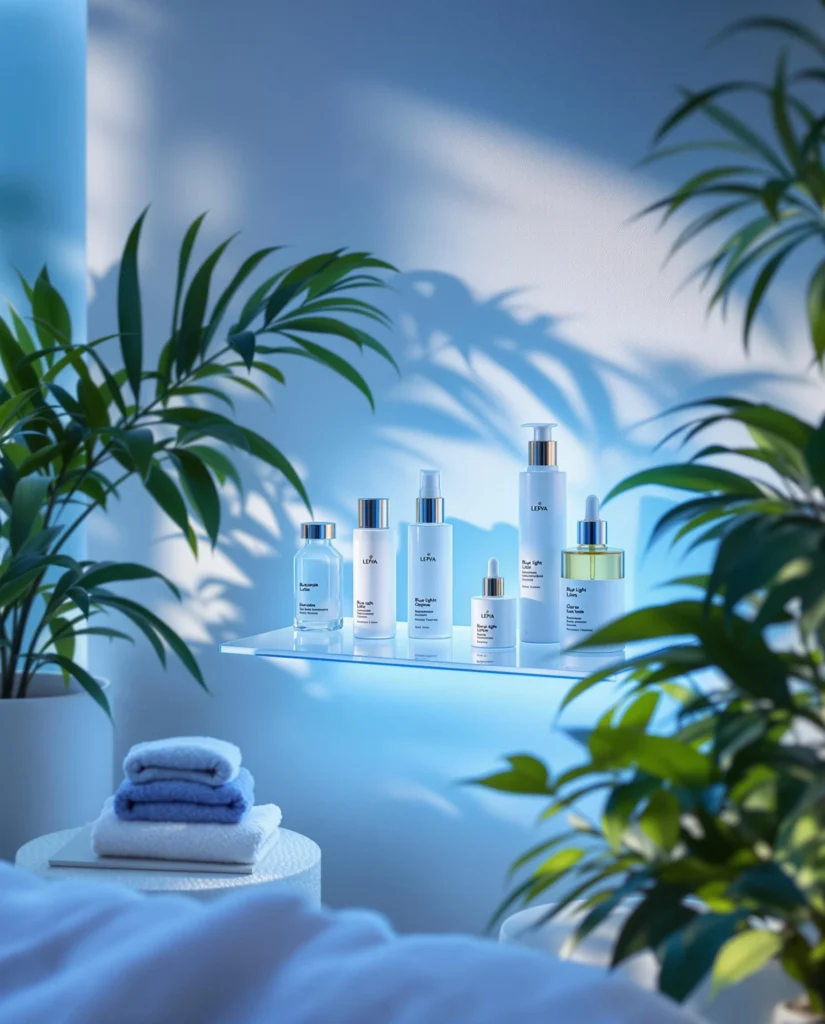
There’s ongoing research into using blue light to disinfect wounds or treat infections in a localized way (sometimes called photodynamic disinfection, if combined with sensitizer dyes). This could one day reduce the need for antibiotics in certain cases, which is very attractive given rising antibiotic resistance.
Outside of infections, some dermatologists are exploring blue light for general skin clarity. For instance, blue light can reduce oiliness: studies report a decrease in sebum production and pore size after regular blue light sessions. There’s also early evidence it might help inflammatory skin conditions like psoriasis or eczema. In fact, the FDA recently approved a wearable blue-light device for mild psoriasis treatment at home. In clinical trials on plaque psoriasis, daily blue light therapy led to continuous improvement in redness and scaling of lesions (though it didn’t completely clear them in most patients). Patients tolerated it well, with no significant skin thinning or UV-type damage, aside from some temporary tanning of skin around the treatment area.
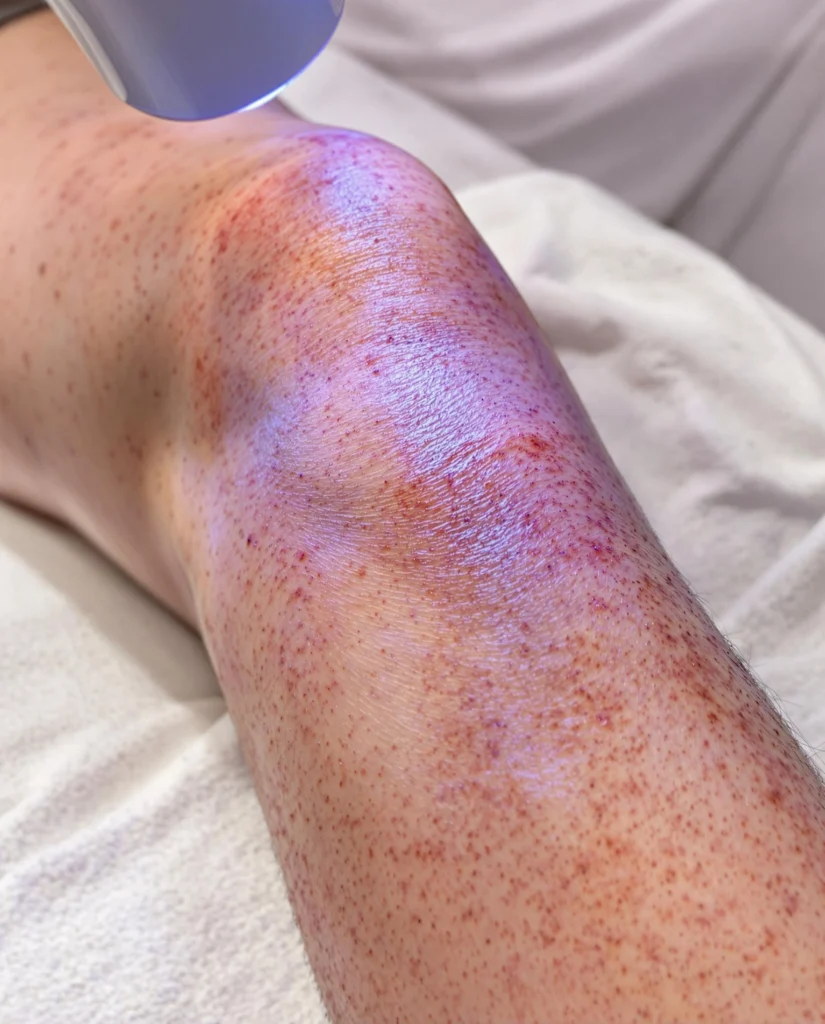
This suggests blue light has an anti-inflammatory effect on skin immune cells, not just an antibacterial one. To be transparent, these non-acne uses of blue light (like for psoriasis, eczema, or wound bacteria) are still preliminary. The results are mixed and sometimes modest. But it’s an exciting area of research. If you have a condition like mild psoriasis or frequent skin infections, you might want to keep an eye on this emerging science – blue light therapy could become a useful tool beyond acne in the future.
Safety, Risks & Side Effects
Blue light therapy is generally considered low-risk when used properly, but it’s important to understand safety guidelines and potential side effects. On the plus side, blue light contains no UV, so it does not cause DNA damage or skin cancer like ultraviolet rays do. Dermatologists even note that in short-term studies, blue light caused no obvious skin aging (no new wrinkles or age spots) when used over weeks on patients. Sessions are also painless – at most you’ll feel a slight warmth. And unlike some acne meds, there’s no risk of antibiotic resistance or systemic side effects.
That said, overexposure or improper use of blue light can have downsides. Perhaps the biggest concern is eye safety. Our retinas are quite sensitive to blue wavelengths. Chronic or high-intensity blue light exposure has been linked to retinal stress and is considered a potential risk factor for macular degeneration (a form of vision loss).
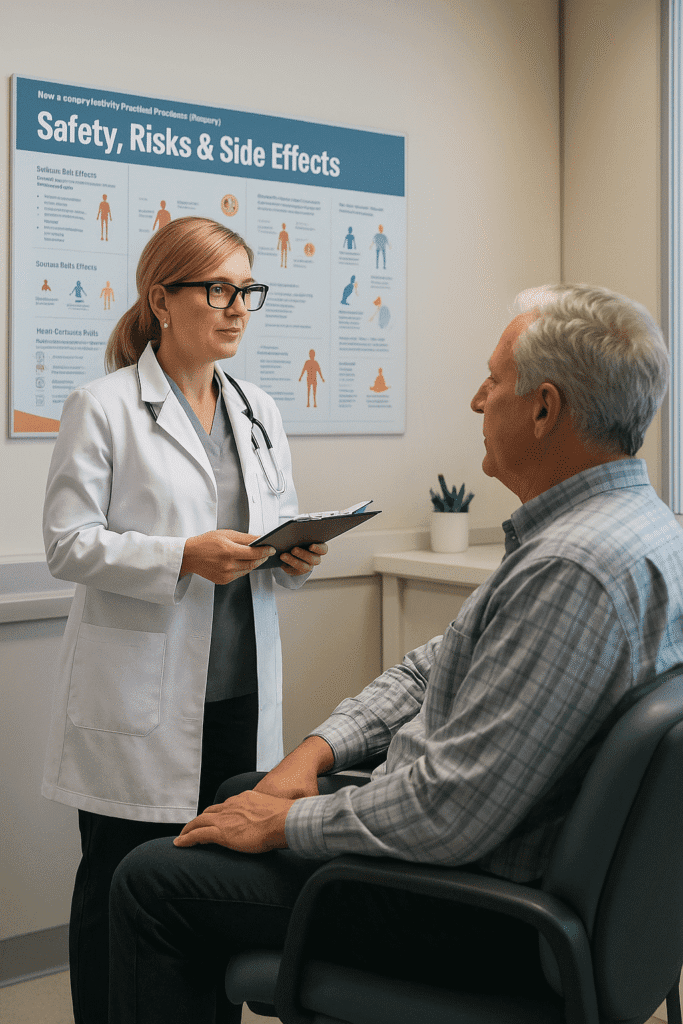
You should never stare directly at a blue light therapy lamp or LED without protection. Most reputable devices come with goggles or have built-in eye shields – use them! If you’re using a blue LED mask, keep your eyes closed or wear the goggles provided to avoid any possibility of retinal injury. Also avoid shining blue light near babies’ or pets’ eyes.
For the skin itself, mild side effects can occur. The most common are temporary redness, dryness, or peeling in the treated areas (sort of like a mild sunburn effect). These typically resolve within a day or two, and using a moisturizer can help if your skin feels dry after treatment. People with photosensitivity disorders (those who are extremely sensitive to light or who have conditions like lupus) should avoid blue light therapy unless cleared by a doctor. Additionally, there’s a nuance with skin tone: visible blue light can trigger pigment changes in some individuals. Research has shown that even relatively low doses of blue light (e.g. 20 J/cm², which is not a lot by clinical standards) can induce increased pigmentation in both melasma patients and healthy skin, and the darkening may last for weeks. This means if you have a history of melasma or hyperpigmentation, you should be cautious – blue light might make dark spots or patches worse. Using sunscreen daily is a good idea because sunlight contains blue light too. On the flip side, any pigmentation from therapy tends to be temporary and lighter than what UV would cause, but it’s something to watch for.
Another consideration is circadian timing. As mentioned, blue light at night can mess with your sleep. Overexposure in the evening (e.g. doing a therapy session right before bed) could suppress melatonin and make it harder to fall asleep. So plan your blue light sessions earlier in the day or at least a few hours before bedtime to be safe.
In summary, blue light therapy is safe for most people when used as directed. Protect your eyes, don’t overdo session length or frequency, and be mindful if you have any condition that makes you extra sensitive to light. Most at-home devices recommend sessions of about 10–20 minutes a few times per week, which is a safe amount. There’s no benefit to using blue light for an hour straight – in fact, higher doses might do more harm than good to your skin cells. Follow the device instructions or your dermatologist’s protocol. If you notice any unusual skin reactions (excessive redness, new dark spots, irritation) or vision changes, discontinue use and check with a healthcare professional. Fortunately, serious side effects are rare; used wisely, blue light therapy has a strong safety profile, especially compared to many medications.
Devices & At-Home Use
Blue light therapy isn’t confined to the dermatologist’s office – there are many at-home devices on the market. These range from full-face LED masks, to handheld wands and light panels that you can use on your own schedule. The convenience of treating your skin at home is a big draw, but not all devices are equal. Here are some tips and considerations for at-home blue light therapy:
Types of devices: The most popular form is the LED face mask (a mask you wear for ~10-20 minutes that bathes your face in blue or blue+red light). There are also wand or spot-treatment devices, which are like little flashlights you hold over a pimple or small area. And for broader use, some invest in larger LED panels that can treat not just the face but other body areas. Most at-home gadgets use a relatively low power LED array – they’re bright, but generally less intense than the machines in a clinic.
Blue-only vs. multi-wavelength: You’ll notice some devices advertise blue light alone, while many others combine blue + red LEDs (and sometimes other colors like amber or green). For acne, dermatologists often favor combination therapy. In fact, clinical trials found that alternating blue and red light (or using both together) led to a bigger improvement in acne lesions than blue light alone. Blue light kills the bacteria and reduces surface inflammation, while red light penetrates a bit deeper to soothe inflammation and promote healing of the skin. If you have a choice, a dual blue/red device might give you more comprehensive benefits – many LED masks on the market use this combo for that reason. That said, blue-only devices can still be effective for targeting breakouts and are usually a bit cheaper. Green light devices also exist (marketed for pigmentation or calming effects), but there’s less evidence behind green light therapy. Most at-home light therapy enthusiasts focus on blue and red, or a combination, since those have the most research backing.
Choosing a device: Look for reputable brands that provide the wavelength specification (for blue light, it should be in the 400s nm range, often ~415nm or 450nm). If a product just says “blue light” without specifics, that’s a red flag. Also consider if it’s FDA-cleared for any condition. In the U.S., some blue light masks have FDA clearance specifically for treating acne, which is a good sign they’ve met safety and efficacy standards. Read reviews and see if the device has been tested in any published studies. Avoid super cheap, no-name gadgets – they may not deliver the right intensity or could have inconsistent output.
Using it properly: Consistency is key. Follow the instructions on session length and frequency. Typically, you might use a mask once daily or a few times per week. More is not necessarily better – adherence over several weeks is more important than doing extra-long sessions. It often takes 4–8 weeks to notice improvements in skin clarity. Make sure to clean the device as instructed (to avoid any bacteria build-up on the surface). And as mentioned in safety, use eye protection if recommended. Many masks have opaque sections over the eyes; if not, wear goggles or keep your eyes closed during treatment to be safe.
When to do it: The timing can be flexible, but a lot of people incorporate LED therapy into their morning or daytime routine – for example, wearing the mask for 10 minutes while having morning coffee or during a work break. This has a practical benefit (blue light can energize you a bit, which is welcome in the morning) and avoids potential sleep disruption at night. If you prefer evening use, it’s wise to do it a few hours before bed and in a well-lit room, so that it’s not signaling your brain that it’s daytime. Remember, blue light is biologically stimulating.
Effectiveness at home: One cautionary note – at-home devices, while convenient, tend to be less powerful than in-office treatments. Dermatologists have access to medical-grade machines that can cover more area with higher light intensities. Home devices “work” but often require longer or more frequent sessions to get a similar result. For instance, a small LED gadget might require daily use on each spot, whereas a professional treatment might be once a week. If you try an at-home blue light regimen and don’t see results, it might be due to insufficient dose or consistency. It doesn’t necessarily mean the concept is ineffective – you might just need a stronger device or a combination approach. Dermatologist Dr. Paul Benedetto notes that it may not be worth investing heavily in at-home blue light if your acne is stubborn; a doctor’s office treatment could be more potent. It’s a good idea to consult a dermatologist before buying expensive light therapy gear. They can tell you if you’re a good candidate and even recommend reliable products.
In summary, home blue light devices can be a great maintenance tool for mild breakouts or skin upkeep. Many users find them relaxing and a valuable part of their skincare routine. Just choose carefully, use them safely, and have patience – and don’t hesitate to get professional advice, especially if your skin issues are more severe.
Search Amazon For Blue Light Therapy Devices
As an Amazon associate, I may earn a small commission from any sales generated through these links. At no extra cost to you.
🇺🇸 Buy on Amazon US
🇬🇧 Buy on Amazon UK
Blue Light vs. Red Light Therapy
Blue and red light are often mentioned together, but they have distinct roles and benefits in therapy. If you’re wondering which one you need (or whether you should use both), here’s a quick comparison:
- Penetration and target: Blue light is shallow-reaching, affecting the surface of the skin (epidermis). Its sweet spot is things like acne bacteria in pores or the very top layer of skin. Red light, on the other hand, penetrates deeper (a few millimeters into the dermis). That means red light can influence deeper skin structures like collagen-producing cells, fibroblasts, and inflammatory cells in the tissue. In acne terms, blue light deals with the cause (bacteria and clogged pores at the surface) while red light addresses the effect (inflammation, swelling, healing deeper in the skin).
- Mechanisms: Blue light’s primary mechanism is photochemical destruction of bacteria and a mild anti-inflammatory effect in oil glands. Red light’s mechanism is often described as photobiomodulation – it’s absorbed by mitochondrial chromophores in cells, which boosts cellular energy production and alters signaling.
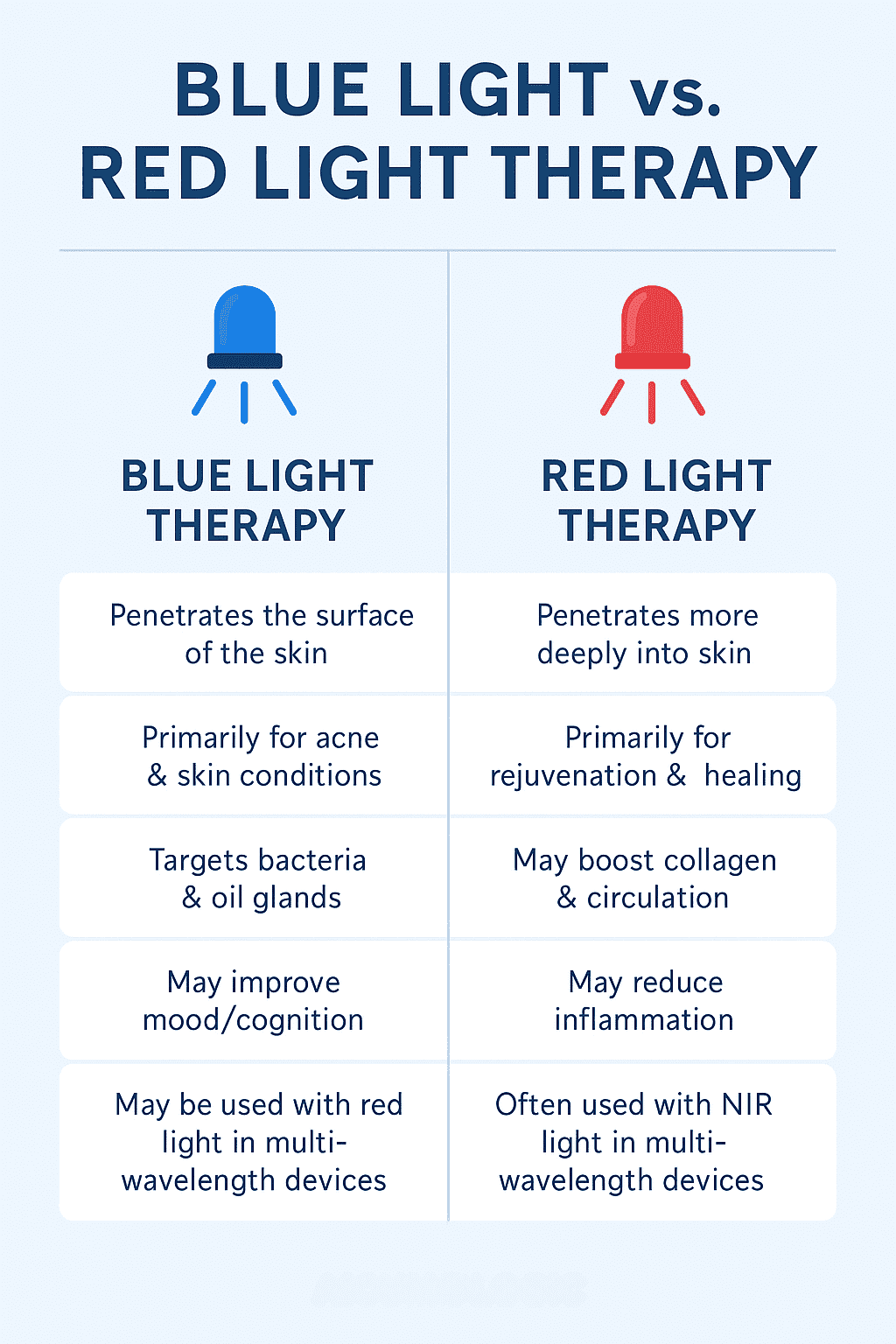
In skin, red light can stimulate collagen synthesis, improve circulation, and reduce inflammation by calming immune cells. Red light doesn’t directly kill bacteria (it doesn’t have enough energy to produce ROS in C. acnes like blue does), but it helps in other ways: it speeds up healing of existing pimples, and can even reduce the oil production and hyperkeratinization that lead to acne formation.
- Benefits profile: Blue light is best known for treating acne (especially blackheads, whiteheads, and mild inflammatory pimples) and for its antibacterial/antiseptic action. It’s also being explored for surface skin improvements (like tone and clarity) and mood/circadian effects as discussed. Red light, by contrast, shines in the areas of anti-aging and healing. Red or near-infrared therapy is commonly used for improving wrinkles, fine lines, skin elasticity, and reducing scars, because it can stimulate collagen and tissue repair. It’s also used for pain relief in joints and muscles (thanks to that deeper reach). For acne, red light helps with inflammation – studies show red LED therapy can reduce redness and swelling of acne lesions and may help prevent scar formation. Red light is also suitable for sensitive or aging skin that needs rejuvenation without any harsh chemicals.
- Combining them: Blue vs. red isn’t an either/or for many situations – they’re complementary. In fact, many acne treatment protocols use blue and red together or sequentially. The blue annihilates acne bacteria and the red soothes the skin and promotes healing. Clinical evidence shows combined blue–red therapy leads to a greater reduction in acne lesion count than blue light alone. Users often find that pairing them leads to quicker and more pronounced skin improvements. Some devices alternate wavelengths or have dual settings for this reason. Outside of acne, someone might use red light in the evening for skin health and blue light in the morning for mood – it depends on your goals.
- Skin type considerations: Generally, both blue and red light are considered safe for all skin tones (I–VI), since there’s no UV involved. However, people with darker skin or melasma may need to be a bit cautious with blue light as mentioned – it can cause transient pigmentation in some cases. Red light is less likely to cause pigmentation issues; in fact, some dermatologists use red/NIR light to help manage pigment by reducing inflammation. If your main concern is acne in oily, acne-prone skin, blue light (with maybe some red) would be the first choice. If your concern is aging, rosacea, or chronic inflammation, red or near-infrared therapy might be more beneficial. Often, dermatologists will recommend blue light for teenage or bacterial acne, and red light for adult acne that has more to do with inflammation and healing – though there’s overlap.
In short, blue light = “clean and calm the surface,” red light = “heal and restore the skin.” They each have unique strengths, and many people ultimately use a combination to get the best of both worlds. If you can only pick one and your main goal is acne, you’d likely start with blue. For anti-aging or general skin quality, red is king. And if you have the opportunity to use both (either via a multi-wavelength device or alternating treatments), you may find they complement each other for maximum skin benefit.
Who Might Benefit Most
Blue light therapy can be helpful for a range of people, but it’s especially beneficial for certain groups. Here are those who might gain the most from trying blue light:
- Acne-prone teens and adults: If you’re breaking out frequently, whether you’re a teenager with new acne or an adult with persistent pimples, blue light therapy is worth considering. It’s a drug-free way to reduce acne bacteria and can be added to your routine without the side effects of medications. It’s particularly useful for mild to moderate acne (those who get regular pimples but not severe cystic acne). For severe acne, it might still help as an add-on, but probably won’t be enough alone.
- People with oily, blemish-prone skin: Got very oily skin or clogged pores? Blue light might help tame it. Some evidence suggests blue light can shrink oil glands a bit and curb sebum production over time. So those with shiny T-zones and frequent blackheads/whiteheads could see improvement in skin clarity and texture.
- Individuals avoiding or unable to use acne medications: Perhaps you’ve tried antibiotics, retinoids, or even isotretinoin and got too many side effects – or maybe you simply prefer a more natural or non-systemic approach. Blue light is a great alternative for people who cannot take acne drugs (for example, pregnant women who must avoid certain medications, or someone who gets stomach upset from antibiotics). While it may not completely replace all meds, it can reduce reliance on them. Even dermatologists use blue light for patients who don’t tolerate traditional therapies well.
- Those concerned with medication resistance or long-term use: Along the same lines, if you’re wary of antibiotic resistance or don’t want to be on prescription creams for years, blue light can be a nice maintenance therapy. Once your acne is under control, occasional blue light sessions (in-office or at home) can help keep the bacteria at bay and prevent rebound breakouts, potentially letting you use lower doses of creams.
- Biohackers and natural wellness enthusiasts: If you’re into optimizing your health with minimal drugs (taking a “food and light as medicine” approach), blue light therapy fits that philosophy. It’s appealing to biohackers for not just skin but also for its effect on energy and mood. For instance, using a blue light device or light box in the morning could boost your alertness as part of a routine. Just remember, any mood use should be carefully timed (morning/day only).
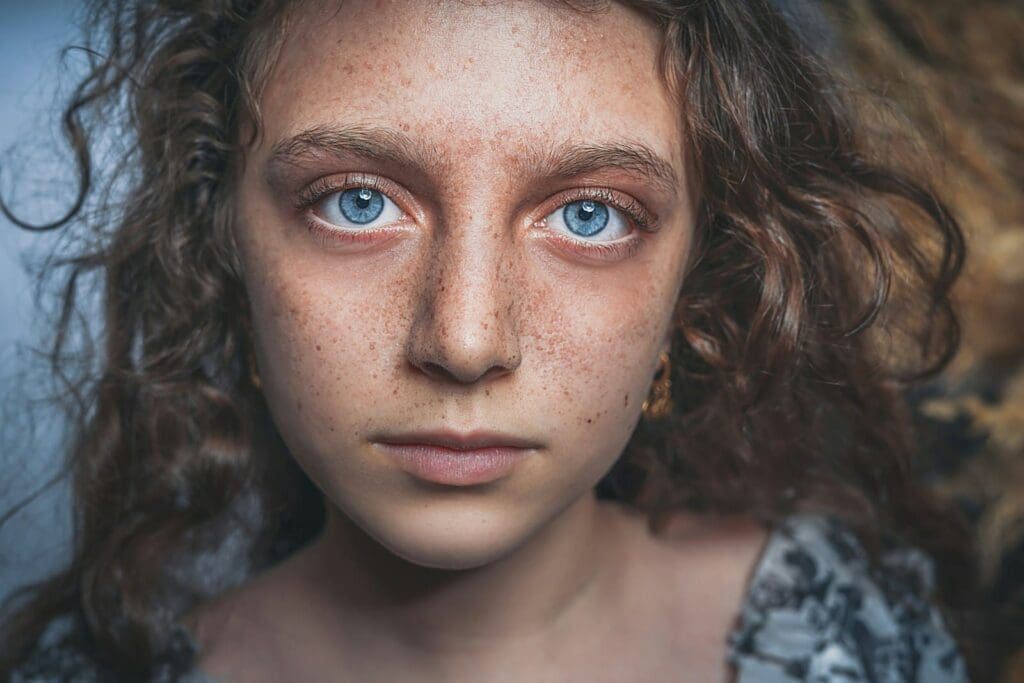
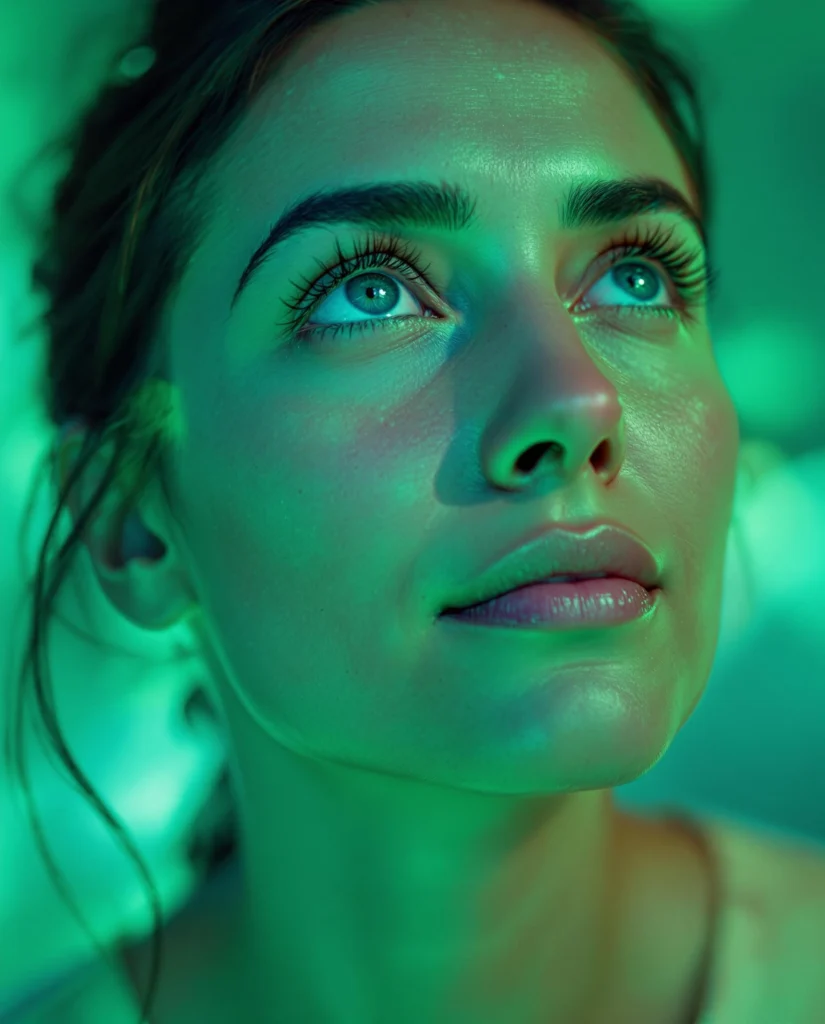

- People with specific skin conditions under medical advice: Beyond acne, if you have something like actinic keratoses (precancerous sun spots) or psoriasis, you might benefit from blue light in a medical setting. Dermatologists sometimes use blue light photodynamic therapy for the former, and there are new wearable devices for the latter. Also, if you get frequent skin infections or have a wound that’s colonized with bacteria, blue light might be an option to reduce microbial load (with a doctor’s guidance).
Of course, virtually anyone can potentially benefit from the mood-lifting effects of blue light on dark winter mornings. But as a rule, the people who see the most direct benefits are those with acne-prone skin or superficial skin issues that blue light targets so well. If you’re unsure whether you’re a good candidate, talk to a dermatologist – they can tell you if your specific skin woes align with what blue light can help.
Blue Light Therapy Podcast
FAQ
Summary
References
Click the tabs above to uncover more information about blue light therapy
Blue Light Therapy FAQ
Summary and Takeaways
Blue light therapy is a fascinating and versatile tool in the natural health and dermatology toolkit. To sum up the key points:
- What it is: A treatment that exposes you to blue wavelength light (~415–495 nm) via LEDs or lamps, commonly used for clearer skin and other wellness benefits. It’s non-invasive and painless.
- How it works: Blue light penetrates the skin’s surface and triggers photochemical reactions. It kills acne bacteria by exciting porphyrins to release cell-destroying radicals. It also calms inflammation to a degree and can influence our biological clock and mood by affecting melatonin and alertness signals.
- Proven benefits: The best-supported use is for treating acne – studies and clinical practice show blue light can significantly reduce pimple counts and inflammation, especially for mild/moderate acne. It’s an FDA-approved approach for acne that offers a safe alternative or complement to medications. Other benefits that have some evidence (though more preliminary) include aiding wound healing (through antimicrobial and tissue effects), improving certain skin conditions like psoriasis or reducing oiliness, and boosting mood/energy in cases like seasonal depression by regulating circadian rhythms.
- What’s speculative or emerging: Using blue light alone to heal deep wounds or treat systemic illness is still experimental – promising early data but not conclusive. Its role in chronic skin issues like eczema or anti-aging is not as established as red light’s role; any benefits there are considered preliminary. Also, while blue light clearly can affect mood and sleep cycles, using it as a therapy for mood disorders should be done carefully (improper timing could do more harm than good). So, acne = yes, strong evidence; other uses = interesting but need more research.
- Safety notes: Blue light therapy is generally very safe. Unlike UV, it doesn’t cause skin cancer. Side effects on the skin are usually minor (a bit of redness or dryness). But protect your eyes – don’t gaze into the lights, use goggles as needed. And be mindful of overuse: more light isn’t automatically better, and too much can cause oxidative stress (which could accelerate aging or pigment issues if you really overdo it). Also avoid late-night sessions to keep your sleep on track.
- Practical advice to start: If you’re keen to try blue light therapy for your skin, you have options. Dermatologist treatments tend to be stronger and fast-acting – consider getting a few in-office sessions to jumpstart results (often covered for acne treatment). For at-home use, do your homework on devices: pick one that’s reputable and follow the instructions. Consistency (using it regularly for several weeks) is key for results. Pair the therapy with a good skincare routine (gentle cleansing, maybe a salicylic acid or retinoid if tolerated) for a one-two punch. And set reasonable expectations: you might see improvement, not perfection, and that’s okay. Blue light is a tool, not a miracle cure.
In the end, blue light therapy offers a science-backed, gentle approach to clearer skin and wellness. It aligns nicely with a holistic or “biohacky” approach – using light, a fundamental element of nature, to nudge our biology in a positive direction. By understanding its strengths and limits, you can safely harness blue light to benefit your skin health and maybe even brighten your mood (literally and figuratively!). Always stay informed and if in doubt, consult a healthcare professional to tailor the approach to your needs. Here’s to enjoying the bright side of feeling blue!
References
- DermNet NZ – Light Therapy for Acne: Explanation of blue light’s wavelength (415–545 nm), shallow skin penetration (~0.3 mm), and its antibacterial & anti-inflammatory action in acne. Also contrasts with deeper-penetrating red light (600–650 nm) used for inflammation and healing.
- Cleveland Clinic – Blue Light Therapy for the Skin: What Can It Do?: Dermatologist insight on using blue light for acne, sun damage, and precancerous spots. Describes how blue light causes an oxidative reaction that kills P. acnes bacteria and notes that it often requires multiple sessions and may be combined with other treatmentsealth.clevelandclinic.org. Emphasizes safety (few side effects for acne use, not for photosensitive individuals)
- American Academy of Dermatology (AAD) – Lasers and Lights for Acne: States that light-based treatments can reduce acne but rarely clear it completely on their own, so they are best used as part of a broader acne treatment plan. Multiple sessions are usually needed for best results.
- Dai et al., 2012 – Blue Light for Infectious Diseases (Drug Resistance Updates): A scientific review highlighting blue light’s broad-spectrum antimicrobial effects. It explains that blue light (405–470 nm) can kill bacteria without external photosensitizers, via excitation of intracellular porphyrins leading to ROS production. Reports successful use against Propionibacterium acnes, H. pylori, and wound bacteria like Staph aureus, while noting high doses can harm mammalian cells.
- Zhang et al., 2023 – Blue Light Therapy in Chronic Wounds (Wounds Journal): A review of blue light in wound healing. It found low-dose blue light can promote angiogenesis, reduce inflammation, and is safe, potentially improving chronic wound healing when added to standard care However, it concludes current evidence is poor and more controlled trials are needed.
- Meesters et al., 2018 – Narrow-band Blue vs. Bright White Light for SAD (J. Affective Disorders): A clinical trial on seasonal depression showing blue-enriched light (100 lux blue) was equally effective as the traditional 10,000 lux white light therapy after 15 days. Supports the idea that blue wavelengths drive the antidepressant effect of light therapy.
- Harvard Health – Blue Light Has a Dark Side (2024): Discusses blue light’s impact on circadian rhythm and sleep. Notably, Harvard researchers found blue light exposure at night suppressed melatonin for twice as long and shifted circadian phase twice as much as green light of equal brightness. Also notes blue light in daytime boosts attention and mood, reinforcing timing considerations for therapy.
- Dermatology Times – Blue Light and Pigmentation in Melasma (2023): Reports an observational study where even a dose as low as 20 J/cm² of blue light induced pigmentation in both melasma patients and healthy skin, which did not fully fade by 2 weeks. Confirms that blue light can cause transient skin darkening and erythema, and that effects are dose-dependent – highlighting the need for sun protection and caution in pigment-prone individuals.
- AAD – Wearable Blue Light Device for Psoriasis (2021): Explains that the FDA approved a blue-light therapy device for mild psoriasis. Summarizes clinical findings: daily blue light was gentle and led to continuous improvement in plaque size, redness, and scaling over 4 weeks (with no serious side effects, aside from some temporary skin darkening around treated patches that resolved.. Only a minority of treated patches fully cleared, indicating it’s helpful but not a standalone cure for psoriasis.
- Healthline – Light Therapy for Acne (Reviewed by Dermatologist): Consumer health resource confirming that blue light has an antimicrobial effect on bacteria in pores and can reduce acne inflammation. Cites research where 77% of acne cases improved after 5 weeks of blue light therapy. Also contrasts blue vs. red light: blue to kill bacteria and reduce oxidation, red to promote healing and reduce scars. This provides a readable overview of how each light benefits acne-prone skin.



